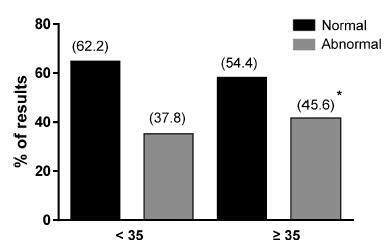Revista Brasileira de Ginecologia e Obstetrícia. 03-01-2017;39(3):110-114

To describe the frequencies of chromosomal abnormalities found in abortion material, and to observe its correlation to maternal age.
A retrospective study was conducted based on data obtained from the databank of a medical genetics laboratory in Belo Horizonte, MG, Brazil. A total of 884 results from products of conception analysis were included, 204 of which were analyzed by cytogenetics, and 680bymolecular biology basedon quantitative fluorescence polymerase chain reaction (QF-PCR). The frequency of individual chromosomal aberrations and the relationship between the presence of anomalies and maternal age were also evaluated.
The conventional cytogenetics technique was able to detect 52% of normal and 48% of abnormal results in the analyzed material. Quantitative fluorescence polymerase chain reaction revealed 60% of normal and 40% of abnormal results from the samples evaluated by this method. The presence of trisomy 15 was detected only by cytogenetics, as it was not included in the QF-PCR routine investigation in the laboratory. A significant increase in abnormal results was observed among women aged 35 years or older compared with younger women (p = 0.02).
Chromosomal aberrations are still a major cause of spontaneous abortion, and the conventional cytogenetics technique is efficient for miscarriage material analysis, but molecular methods such as QF-PCR are adequate complementary strategies to detect the major chromosomal anomalies, leading to technical reports with reliable results.
Search
Search in:


Comments